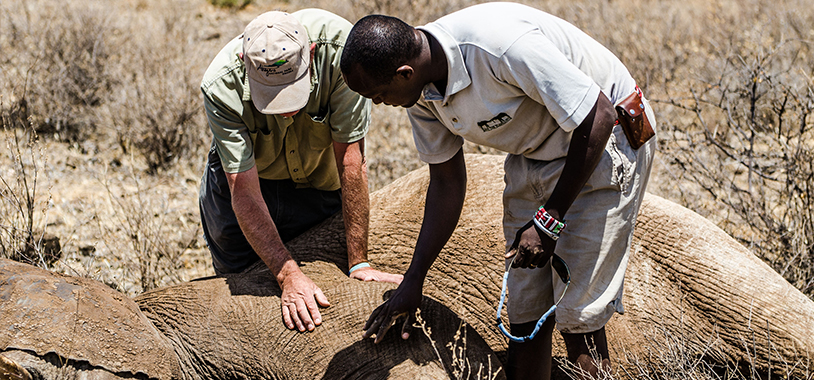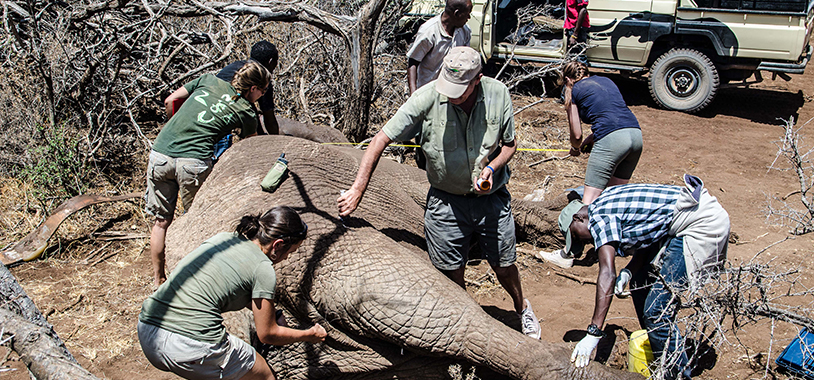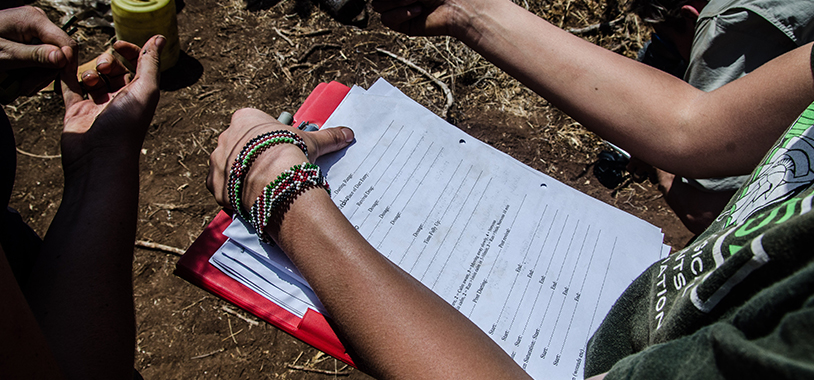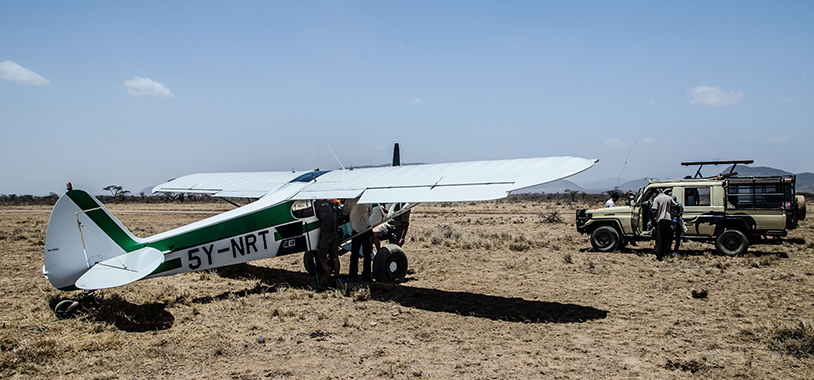We left Wendy, her grandson, and the rest of the Poetics at the base of Gir Gir, a large flat-topped escarpment near the eastern border of Samburu yesterday evening, bathed in golden light and our concern. I’d hoped that action would be swift to coordinate an operation to treat both of the wounded elephants as well as re-collar Wendy, the princess of unlucky collars. I wasn’t prepared for just how quickly Save the Elephants can muster up the necessary parties to achieve such a goal.
David Daballen, the head of field operations here at Save the Elephants, joined us as the sun set behind the palm trees last night to assess the situation and quickly placed a call to a vet based in Lewa Conservancy to our south. Securing a veterinarian for these kinds of operations is more challenging than you might expect – there are only two regular wildlife veterinarians for the whole of northern Kenya. Coordinating around their availability and then transporting them up here either by road or plane is both time-intensive and expensive, but Save the Elephants’ relationships with these veterinarians and their respect for their time means that working as a team comes as easy as breathing once everyone is in place.
With the vet confirmed, we all woke before dawn to hot tea and bread. The moon had set, the twilight stars still twinkled in the sky. As we sipped tea behind blurry eyes, we worked out relatively simple goal. Locate the family. With wandering Wendy’s penchant for avoiding us over the past few days, we didn’t want to lose her again. So with the sun rising in the east, we rumbled out of camp in the cool morning air, Jenna, Leigh-Anne, and I all singing a chorus of “The Circle of Life” as Shifra punched the accelerator up the main road.
We meandered in the foothills in the northern portion of the reserve, thinking that maybe Wendy had led the family into them for the evening. We were rewarded with an early morning sighting of a large group of the Royals, retreating slowly back to the river after a night in the hills. But no sign of the Poetics. Perhaps southward, back to Buffalo Springs and her old stomping grounds?
With the main bridge to our sister reserve closed for repairs, we had to drive completely out of Samburu, through the small town that borders it, Archer’s Post. Upon immediate exit from the park, the dust turned to calcrete powder, trash littered the ground, and skinny goats scampered under trees. A short jaunt on a paved highway and then entrance into Buffalo Springs’ eastern gate put us squarely back in elephant territory. We had only driven about fifteen minutes, turning to check out a favorite swamp for elephants, when a collar and a conspicuously one-tusked female emerged from the thicket. The wandering Wendy had been located, but her grandson remained unaccounted for.
Wasting no time, we radioed in her discovery and the vet boarded the tiny two-seater plane that brought him to Samburu and winged his way over the river to land bumpily in a clear area near the females. The plan then rolled into action – slowly at first. David Daballen is an old hand at this kind of operation and his unflappable demeanor was a model for behavior. This wasn’t some Hollywood, flashy camera operation – it was commonplace, nothing to get too excited about. It’s this calm that is paramount to keeping stress on the elephants and the crew as low as possible.
The call came over the radio in David’s lilting, quiet voice – “Dart in.” The waiting game started then – four minutes, five minutes, and then an almighty trumpeting erupted from the opposite side of the swamp. Wendy had gone down and her family was distressed. Using the collection of cars in the caravan, a vehicular wall was established around the downed matriarch, driving her trumpeting family off so that we could move in. They weren’t giving up easily, another large female charged Daniel as he hopped out of the car, waving his arms and shouting at her. It was distressing to have to separate them, but not more distressing knowing that Wendy was in pain.
With the car wall in place – the team jumped into place. Sticks were placed in her trunk to keep her air passages open. Antibiotics were readied and injected into her thigh. Her foot was cleaned and the vet tried to locate any open wounds – with no success. The point of entry was cleansed but not re-opened as it had already healed over to some degree. Shifra plucked tail hair for isotope analysis and clipped a tiny piece of ear for a tissue sample, producing an unanticipated amount of blood to our dismay. Measurements of her feet were taken, the circumference of her tusk jotted down. Old collar off. New collar on. I stood watch in the back of the Land Cruiser, and at one point had to yell a head’s up to the team as a female attempted to sneak around the motorcade in the bushes, causing everyone to scatter. But a rev of the engine drove her off again and everyone returned quickly to their task. In the span of just over ten minutes, the operation was over, the antidote administered, and the new collar attached. New bling for the big mama.
As we pulled our cars away, Wendy flapped her ears, showing the first sign of lucidity. After a few minutes, she heaved herself up to her feet, undoubtedly feeling the force of an M99 hangover. She shambled into the shade of a tree, re-orienting herself, and then moving out into the open to rejoin her family. As we turned our eyes to the direction she was walking, a small group of elephants was sighted just three-hundred meters to the east. To our relief it was her daughter and with her, the limping grandson.
With little delay, David rumbled out across the scrubby plane, slowly driving close to the herd, and plunk the pink-tipped dart made contact with the haunch of the young male. His mother, ever the fierce protector made her displeasure known as her son clumsily trotted away after his prod. The same protective instinct expressed by the female in the swamp was echoed by this mother and she kept her son close as they walked away from the car. The dart had fallen out, and without warning one of the other females in the small group delicately picked it up and went to place it in her mouth – much to our displeasure. Treating an elephant that had swallowed a syringe previously filled with industrial strength sedative wasn’t something we wanted to do. But luckily it didn’t make it down the hatch and David quickly retrieved it when she dropped it.
The young male stuck close to his mother as he started to feel the waves of sedative take over. He swayed a bit – she rumbled and flared her ears in concern. But as he stopped moving, finally coming to a stand-still, the cars moved in to wall him off from his warrior mother. David walked right up to him and as the young bull turned to look at him he fell on his good side, exposing his swollen leg. Like his thick-skinned grandmother, the young bull’s wounds appeared to have healed over and opening them again to retrieve a small bullet may put him at a risk of infection. Instead, the vet administered a whopping dose of antibiotics and we crossed our fingers that that would be enough. Down only for just over five minutes, the young male woke quickly after the antidote had been administered and quickly joined his mother, and by that time, the very drowsy Wendy who had come to join them.
With the family reunited, and the collar looking good on Wendy, we called the day a success. Dusty, we returned to camp with positive feelings and a hope that antibiotics will do the trick to keep the injured Poetics on their feet for many years to come. It was a privilege to see how effortless and practiced this operation was. The utmost care was taken to ensure the safety and health of the elephants under treatment. It’s this kind of care and deep concern for these animals that certainly earns this organization it’s name – Save the Elephants. I’m more than pleased to be part of their team.





